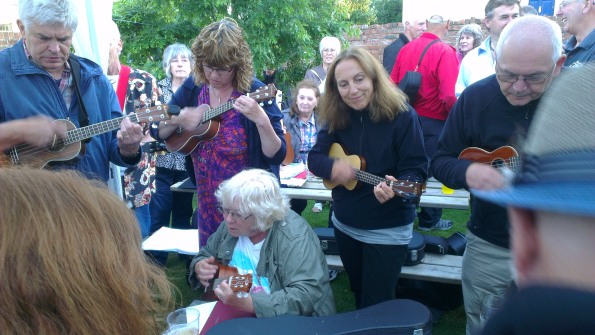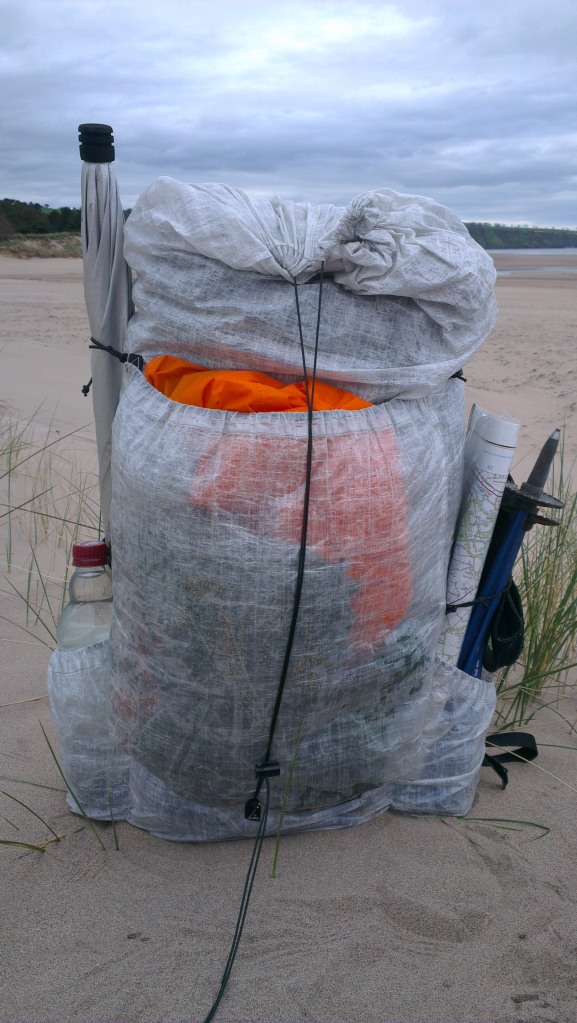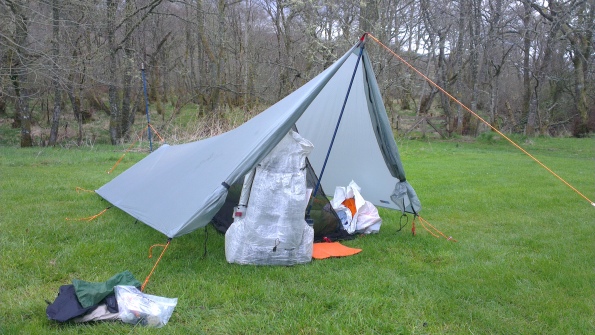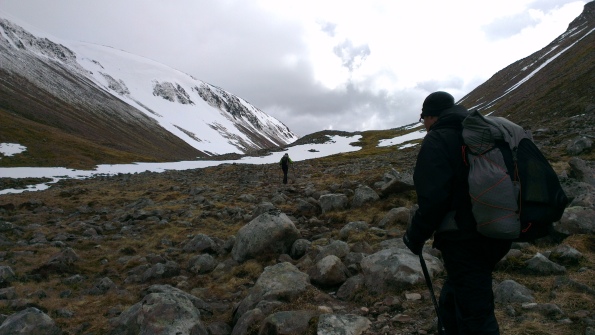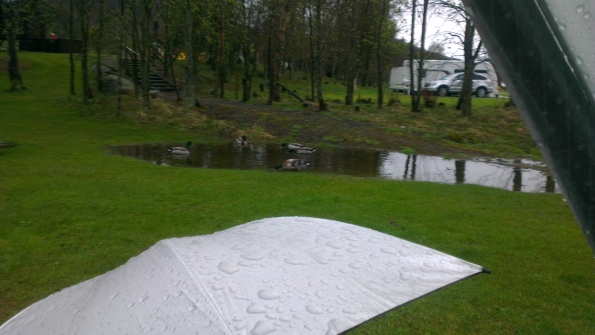Imagine a pun-filled, clever title about ukuleles for this blog post
I should get out more.
The sun was shining when The Lovely Emma and I reached Cheltenham, the first time I had been to the town. Staying in a Travelodge over the road from GCHQ might not have screamed glamour, but it was cheap and convenient thanks to excellent (indeed, rather plush) buses. Dumping everything bar our ukuleles we made our way to The Exmouth Arms, which was hosting a large part of the Ukulele Festival of Great Britain on Friday evening and Sunday, with the main event taking place at the town hall throughout Saturday. If you’re going to start a new experience in a strange place then you might as well do it with a decent pint in your hand.
There’s a wonderful effect you can experience at festivals and conventions of this sort, something I’ve also noticed at the UK Games Expo, where complete strangers are immediately friendly due to a shared interest and lack of any reason to be competitive or unpleasant. It was even more noticeable at the ukulele festival, since it was so easy to spot people who were attending by their ukulele cases, leading to friendly waves and hellos from people we’d never met before even when strolling around town, away from the actual events. On Friday this quickly translated into groups strumming away and singing together, with a few frighteningly organised individuals even coming prepared with additional song sheets. I’d taken a couple of Levy Uke Up songbooks, as well as several sheets I’d put together myself such as Daft Punk’s Get Lucky, which works considerably better than you might expect. Since I’d originally misheard the song badly, briefly believing in the finest tradition of mondegreens that one of the lines went “Are all bald Mexicans lucky?”, it actually went rather better than I expected, too. By the time the sun had set and we were improvising with iPhone torches under the marquees I’d pretty much lost all feeling in my strumming hand.
Saturday brought a rainy start, but the main event was set to be in the town hall anyway and so was unlikely to be disrupted. We wandered around town, enjoying the Regency buildings and general airiness of it, and happened to stumble across Kit Williams’ Wishing Fish Clock, which I knew of but hadn’t realised was in Cheltenham.
Even more exciting than that, if only for me, was finding a sweet shop selling these:
It’s been years since I had eaten a Zagnut bar, so long in fact that they were made by a different company back then. Almost unknown in England, they were hard enough to find in some parts of America. This was the only one in the shop; I almost cried. Happily, especially given the eye-watering price tag, it was every bit as delicious as I remembered. Anyway, ukuleles…
The festival had a room set aside with various commercial stands, mostly selling instruments although there was a small amount of peripheral material. To be honest this seemed like a missed opportunity. They sold quite a lot of ukuleles over the weekend which, although they may be relatively cheap by musical instrument standards, are expensive items, but there was surprisingly little in the way of impulse purchases. I rather expected to see lots of T-shirts, cards, badges, novelty items and so on, but there was hardly anything of that sort. Somebody could really make a few quid there. The stalls were great, a wonderful opportunity for us both to play a wide selection of ukuleles, particularly handy as Emma is shopping for a new soprano at the moment. Hands on is really the only way to buy an instrument. There were several beautiful, eye-catching ukuleles we tried which sounded quite flat, dead or uninspiring when actually played, along with a few real surprises; you simply cannot judge a musical instrument on looks. The Ohana table was intriguing, although also rather confusing as around half of the ukuleles were not for sale, being prototypes or samples, and it was a little unclear as to what the stand was for. Since I already have an Ohana I just took the opportunity to try out some of their other models and a few sadly not destined for production.
There was a full lineup of acts from about one o’clock until almost eleven, so inevitably we missed a couple. By all accounts Sarah Maisel was fantastic, so it’s a pity that we were off doing other things and didn’t get to hear her. Sam Brown’s International Ukulele Club of Sonning Common started things off in hard-to-follow fashion, more than three dozen musicians, talented and well rehearsed, showing that ukulele clubs can be more than slavishly strumming “I’m a Believer” in unison.
At this stage we’re into low light pictures taken with my mobile ‘phone, so I’m afraid that the quality will be a little grainy.
The excellent crew cleared away the chairs and gear in short order, which did leave an unfortunately empty stage for Nicholas Abersold, making him appear rather lost and lonely and not making for the easiest setting for his performance. He might have done better if there’d been a smaller band on before him. Neither myself nor Emma had a clue what to make of Elof & Wamberg from the programme description, some sort of Nordic folk jazz duo apparently, but they were absolutely stunning. You know you’re watching real talent when someone like James Hill (with whom they have toured, it says here) joins them on stage for a number. Emma was particularly impressed with Ukulele Uff and Lonesome Dave, a duo I’d come across on YouTube last year but paid little attention to since. Their set could probably use a little work on pacing, as even when they slow things down they still rattle along at quite a rate, but you’re unlikely to see a more jaw-dropping demonstration of high speed right hand work on any stringed instrument. And Ukulele Uff is a Cliff Edwards fan, so there’s really nothing to be said against them.

Elof & Wamberg with James Hill. Full marks to Nicolaj Wamberg for the best trousers of the festival.
Phil Doleman and Ian Emmerson, no longer performing as ukulele duo The Re-entrants but instead as a ukulele duo not called The Re-entrants, combined virtuosity with humour and relaxed patter that really made the fairly large hall seem more like an intimate front room gig. Many of the acts made us wish that they had more than half an hour available, certainly true of these two.

Lacking a zoom lens or the Hubble Space Telescope I couldn’t even see the tiny uke played by Ian Emmerson here.
Something very different for the show arrived in the shape of Mr B. the Gentleman Rhymer, whose act has been thoroughly tempered in the fires of clubs, cabarets and Glastonbury. The result was polished, energetic and not all about his banjolele, which might have caught some of the audience by surprise – I’m not entirely certain that jolly songs about crack cocaine and acid trips were quite the standard festival fare – but by the end of it he’d won the hall over, whether they previously knew hip-hop or not. The only pity was that, in a rare misstep by the sound crew, his vocals were a bit muffled at times.
I’ve skipped over many other acts, some very impressive and others hugely likeable (I wasn’t sure that I’d think much of The Winin’ Boys until frontman Fred took the stage and showed what a difference some personality makes to an act); only one that I saw was not at all to my taste, to the point that I left the hall to escape it, which is pretty good going for a full day of music. The evening ended with the biggest name at the festival, James Hill.
Accompanied by Anne Janelle, who could very easily have been high on the bill in her own right, James Hill presented such a seemingly effortless display of virtuosity and complete musical understanding that I was torn between being powerfully inspired or deciding to just jack it all in right there and throw my uke in the toilet. A genuine superstar of the ukulele world he not only performed his famous version of “Billie Jean” but also played the ukulele with chopsticks and a comb at one point. His voice sounded even better than on his last album, the songs were beautiful and his playing was quite breathtaking. Annoyingly, he is by all accounts a thoroughly nice chap and a real gent. A Faustian pact is the only possible explanation.
To finish off the night most of the acts returned to the stage for a terrific last song, in which James Hill showed that he can play the bloody violin as well.
The end of a fantastic day, with the promise of a great Sunday to follow and the Big Busk of all the festival goers playing together in the middle of town. My first music festival, certainly not my last. As a matter of fact I’m about to book tickets for another right now. Hats off to the organisers, attendees and performers at Cheltenham, a thoroughly enjoyable, utterly inspiring weekend.
Pity I forgot to put my hat down at the busk, though… might have made enough to cover lunch…
TGO Challenge 2013: Reflections
A few weeks have passed since I headed home from Scotland and the 2013 TGO Challenge is very much behind me now. Trip reports have appeared on a wide variety of blogs, routes and gear have been discussed, amusing anecdotes (and a few rather less amusing ones) retold. It’s very much time to look for the next adventure.
It was a strange finish to the walk for me this year. After leaving Tarfside, walking alone again, I started to feel that I simply wanted to get to the coast. Many walkers will tell you that the eastern part of the crossing is unsatisfying, but I think that I was especially unfortunate with my choice of route this time, a slog through rather industrial farmland and strangely forbidding hamlets. Even so, there are always bright moments: at one point I realised that a car was drawing alongside me, a shabby hatchback seemingly driven by the sort of man who is either living an homage to Deliverance or on the lookout to score some cheap Buckfast… my heart sank. And then he spoke, and instead of the mockery and jeering I expected he turned out to be cheerful and enthusiastic about my walk (once I’d explained why I couldn’t accept his kind offer of a lift) and I quite clearly shouldn’t judge people as I did, which is one of the inevitable outcomes of living in Manchester. Considerably buoyed as he waved and drove on, I continued towards Lunan Bay.
My planned route to the coast didn’t survive for long. Enjoying a spot of lunch between the White and Brown Caterthuns, a couple of Iron Age hill forts which turned out to have excellent mobile ‘phone reception (very forward thinking people, the Iron Agers), I decided to press on a bit since the weather was glorious. I’d heard that there was a campsite at Brechin, which turned out to be one of those strange towns where the modern world has rendered past glories into liabilities; the place was full of churches, most of them up for sale. The site turned out to be right next to the road and not especially tent friendly, then I discovered that the chap running it was out and would “probably be back soon.” I sat and looked over the map, considering my options… then I picked up the rucksack and started walking, slipping into that rather dangerous “sod it, I’ll just keep going” attitude. And keep going I did, right on to the coast, arriving at Red Castle in the evening, well ahead of my planned schedule.
This was a little ridiculous, since I wasn’t supposed to reach the coast until Thursday and I was actually there two days early. Red Castle itself, home largely to rabbits and seagulls, struck me as a fair place to pitch my tent for the night, so I decided to head down to the beach and cook a meal, waiting until later to set up camp so as not to be in the way for anyone trying to enjoy an evening stroll in the area. Dinner on the beach was quite delightful, with the section I was on being separated by a channel from the main part where people were dog walking and flying kites. I happened to spot a birdwatching hide, which I discovered was unlocked, so I sat in there for a while when the wind picked up. Naturally I didn’t set up my mattress on the benches and spend the night there, though. Naturally.
A few miles in the morning took me to Montrose, where I met a number of the early arrivals and those people who had sadly had to drop out for various reasons. Quite a few seemed to have finished earlier than they planned as I had. It was rather nice to meet people as they rolled into town over the next couple of days, spoilt only by a bout of suspected food poisoning from a chicken salad I unwisely ordered at the hotel, the effects of which stayed with me for over a week and kept me off work for days. As a result I was in an unusual frame of mind at the end of the Challenge.
I spent a lot of time, both when walking to the coast and as I sat around feeling grim and sorry for myself, thinking about the Challenge and how it had worked for me this time around. This was my third and I had certainly learned quite a bit since the first one, but I had to admit that I had done a poor job of planning the route, cobbling it together hurriedly during a period of blackest winter depression when I was seriously regretting having even applied for the walk. Importantly, I had reached the point at which I knew a great many Challengers so the social side of things was wonderful, bumping into people I’d encountered on a hillside a couple of years earlier. This is a major reason why the Challenge has such a hold on people, I suspect, as there’s no reason why you can’t just go walking across Scotland at any time but meeting fellow Challengers makes it something special. That may be one reason why the last couple of days left me feeling a little hollow and directionless, as I left everyone behind and pressed on.
In previous years I have started the Challenge with great intentions of really getting back into walking, something I’ve done much less of since moving to Manchester, then by the time I’ve reached the coast I’ve pretty much been ready to pack away the gear and never venture out again; indeed, the last time I did any serious backpacking before the 2013 Challenge was the 2011 Challenge… Coming home this time I realised that my goals had shifted a little. I’ve been out walking since I came back and have plans to get out more often, mostly relatively local walks reachable by public transport but Manchester does at least sit on the edge of some fine walking country. I realised that I very much want to look at some of the other major trails around the country, routes I’ve neglected in recent years, ambitions I’ve put aside. Smaller trips, long weekends or perhaps a week taking in some different routes closer to home. At this point I have absolutely no idea whether I’ll apply for the 2015 Challenge (every other year is the best I can aim for, as it eats up my holiday allowance rather badly), yet I do know that I want to get back to frequent walking and that I’ve let things slip away in recent years. I went walking with friends last week, a ten mile loop to help them train for an upcoming charity walk, and as we stood outside a shop in Littleborough at the end, eating ice creams in the sunshine, a simple walk in the British countryside seemed like the grandest thing in the world.
This sort of thing ain’t my bag, baby!
The rucksack hasn’t changed since my 2011 TGO Challenge, a semi-custom ZPacks Zero constructed from Cuben Fiber, and it’s still going strong. Such a light bag requires some thought across your entire range of kit, since you can’t overload it and expect it to be comfortable, nor does it take kindly to being loaded with gear any old how. For my needs it once again proved to be superbly comfortable with the fairly light load I was carrying and is showing very little sign of wear and tear, a popped stitch on the haul loop being about the extent of it so far. Were I to add a few more pounds or take bulkier equipment then this would not be the right pack for the job.
The brolly you can see furled and stowed in the picture was a silvered version of the Swing LiteFlex Trekking model I’ve used previously, but unfortunately this didn’t fare so well. I recall Colin Ibbotson, I believe, mentioning some failures he’d had with this brand and sadly a rogue gust snapped a stretcher on mine, causing it to tear through the canopy. A repair left it able to fulfil some duties as long as there was no chance of much wind, but I’ve had to bin it now. Excellent as a cooling sunshade, a very convenient tarp porch cover and an essential shelter on rainy breaks, I’m still a great fan of the umbrella when hiking, but these particular models are just a little too light, too weak.
On previous Challenges (and indeed most of the time when I step outside, for the past twenty years) I wore a Tilley Hat. I have rather too many of these, if I’m honest, despite not having bought a new one for several years; looking at the range now it all seems a bit cluttered and fancy, somewhat removed from the solid outdoors credentials of the originals, but a few of the venerable models are still there including the classic T3. This time I took the plunge and made a change, a peaked cap from Marks & Spencer costing an impressive £2 from the sale bin. These were most likely poor sellers due to being labelled as size XL but actually being big enough to fit me, which makes it more like an XXXL (the availability of a size 8 is one of the reasons I discovered Tilley Hats in the first place, the world being unfairly biased towards people with tiny heads). My thinking here was that I could wear the cap more easily under the hood of my windshirt or waterproof, which certainly worked. I wore the thing practically non-stop for the fortnight and it even stayed neatly on my head without a chin cord, only once blowing off… when I returned to Manchester. Naturally, it landed straight in a fountain. Despite a foldaway neck cape I did get a little too much sun on my ears, so I expect I’ll go back to full brim hats most of the time.
A large number, perhaps even a majority, of Challengers can be seen to use Crocs, particularly the classic enclosed sandal style, because they are very often hanging from their rucksacks. They may not pack neatly away, and they are certainly astonishingly ugly lumps of plastic, but they are quite light (around 300g for a large size men’s pair), easy to clean and very comfortable. Boot wearers switch to them in camp and also when fording streams, whereas those who opt for trail shoes generally walk straight through the water regardless and wear the same shoes in camp as when hiking. Sometimes it’s nice to have a change, though, and since Crocs were too bulky and a bit heavier than I’d like I made a pair of flip-flops:
A couple of bits of spare foam from my sleeping mat and a few strips of duct tape. 23 grammes for the pair. Absolutely perfect for using in campsite showers and pottering around a bunkhouse. They made it through the fortnight intact, albeit with little cushioning left under the heel.
After the 2011 Challenge I was largely happy with my cooking system, but having seen a Trail Designs Caldera Cone in action I thought it might fix the one weak point, namely the inadequate foil windscreen I was using. Last year I bought a Caldera Cone but otherwise kept the same Esbit burner and titanium pot (the one minor annoyance with the Cone is that it has to be bought to fit specific cooking pots, as it can’t be adjusted). Cooking performance and convenience was vastly improved and I also saved on quite a bit of fuel, as I could generally manage both the main meal and a hot drink on a single tablet. I ate well and it never seemed like a chore to set up the stove.
Most of the other kit performed well and much of it had been in the bag for the 2011 Challenge. A pair of Jacks ‘R’ Better Down Sleeves made my old PHD Minimus Down Vest much more versatile, giving me increased flexibility for sitting around camp and to boost my down quilt quite a bit on a couple of chilly nights. I only had one night when I woke up cold, which was fixed by reaching for extra clothes; in the morning the spare water bag was frozen and I draped the quilt around me as I left the tent. My Mountain King walking poles are still going, giving me occasional concern as they flexed alarmingly when used as tent supports on windier nights, and I wore the same pair of Inov-8 Flyroc shoes that I used on the 2011 Challenge, although they certainly won’t manage a third.
Instead of my old GoLite Cave tarp I tried a Gossamer Gear SpinnShelter. Slightly longer and considerably lighter with useful doors at each end, it’s also less versatile than the Cave as it can only really be successfully pitched in one basic configuration. The tent is not currently in production as the fabric used is now virtually impossible to obtain, but it certainly deserves to reappear if an alternative material can be found. The classic sloping shape only allows you to sit up at one end, but it kept the weather out successfully and was fairly straightforward to pitch tautly. An inner from BearPaw Wilderness Designs, the Minimalist 1, kept the ticks and midges out and as I specified a silnylon area at the foot end it meant that I could keep the doors of the Spinnshelter open, reducing condensation without risking wet feet from the rain. I originally bought the inner for my Cave, but it fit the SpinnShelter quite well.
Trousers were a pair of stretch Sprayway Compass Pants, very comfortable and surprisingly weather resistant with well designed zipped pockets, and a Rab Meco 165 shirt (bought, like the trousers, in a clearance sale) worked splendidly to keep me comfortable in challenging conditions. Instead of the Paramo 3rd Element jacket I wore in 2011 or the Snowsled Ventile smock from 2009 I decided to take a Marmot Essence waterproof jacket (which I normally pack for cycling use, hence the eye-watering shade of orange) and a Rab Cirrus hooded windshirt. The Cirrus was fantastic, good for all but heavy rain and one of the few windshirts around at the moment with big useful pockets. The Essence was okay and worked well, but for the very typical May Scottish weather of the TGO I think I’ll go back to the Paramo in future. Less faffing around as conditions change, which they do quickly and often, and supremely comfortable in cold wet weather.
Would I take the same on a future, hypothetical Challenge? Some of it. I might go back to a thicker mattress (my foam MultiMat is rather flattened with use and age now, for one thing), tweak a few things here and there, but very little genuinely needs to be changed. It doesn’t take a huge amount of gear to be comfortable on the Challenge, with the caveat that I choose my route accordingly: I wouldn’t think of deliberately camping high or in very exposed locations with this exact kit. I carried about 4lbs more this time than in 2011, extra weight accumulating from more and heavier warm clothes, the tent inner, sturdier tent pegs and numerous other odds and ends, which I don’t regret at all. The compromise between weight and comfort is always there and I managed to be comfortable due both to a fairly light pack and a very adequate range of camping gear. I don’t have any set ideology here, though, and you’re just as likely to meet me on a hill wearing leather boots as trail shoes. Horses for courses, as they say.
Ooh, a packhorse… maybe I could take a packhorse…
What Has It Got In Its Pocketses?
Continuing my unsystematic method of writing about the 2013 TGO Challenge, a few idle thoughts (of a very idle fellow) concerning the kit I carried. Whether you call it hiking, hill walking, tramping, rambling, backpacking, bimbling or some equivalent in a long dead tongue, the important thing to remember is that it’s about the journey, the experience, the act of being out there and moving at nature’s pace, and it’s certainly not about the gear. Except that’s what everyone talks about, because people are like that. Anyway, if you want trip reports you need to be following people like Philip Werner, who started his TGO piece this week. It contains a couple of pictures of me grinning buffoonishly and Philip is comically generous in his estimation of my tent pitching skill, but don’t let my presence put you off. I kept photobombing the poor chap’s walk.
So, what worked? With some doubts and fears for its safety I decided to take my smartphone, not a cheap item (for me at least, it’s a very rare bit of fairly high-end electronic folderol) and an inherently fragile one. Despite being relatively new to the world of contract ‘phones I upgraded last year to an HTC One X, which has done fantastically well at pretty much everything I’ve used it for. I made a protective case for it using bubble wrap and an aLoksak, essentially a very overpriced sandwich bag, which worked to fend off moisture and minor bumps, although I was under no illusions about it protecting the ‘phone against a fall with my ample bodyweight crushing it against the rocks. A silica gel pouch added a little defence against moisture in the bag, keeping the humidity down but not likely to do much if the seal failed. The resulting package fit nicely in the pocket of my Rab windshirt.
There’s no user-replaceable battery in that particular model, so I also carried a TeckNet battery pack, capable of recharging the ‘phone up to four times before itself needing a charge; my thinking was that I’d rather leave the battery plugged in at a campsite or pub than I would the ‘phone itself. In practice the battery pack proved fickle, apparently very unhappy about the generally low temperatures, and had to keep being prodded in order to continue charging, but it has worked and continues to work perfectly well at home and when travelling. It also behaved itself in the pub, allowing both myself and Philip Werner to simultaneously recharge our ‘phones as we made use of the reasonably priced WiFi at the Fife Arms in Braemar. The result was that I had a way to call and text Challenge Control (on those occasions when I had a signal… not in any way guaranteed and there are many known signal dead zones in the Highlands), an entertainment centre including MP3 player and a Kindle reader app with plenty of books, and a back-up mapping source; in common with many modern ‘phones it could also function as a torch and a radio if needed, too. The HTC One X, pouch, headphones, charging cable etc came to about 250 grammes and the battery pack 200 grammes (roughly a pound in all), so a fairly heavy bit of kit for someone hiking in a relatively lightweight style but I found it to be worth carrying.
While I’m not here to recommend a particular ‘phone or even operating system (The One X uses Android, if you didn’t already know) I will point to an app I sometimes used and have found to be very handy indeed, Arthur Embleton’s Grid Reference. There are likely to be similar apps for other operating systems. Grid Reference does one thing: turn on the ‘phone’s GPS and it displays, big and bold, filling the screen, your UK mapping grid reference. That’s it. A few seconds and there it is, handy confirmation of your position for those occasions when visibility and local conditions make a little reassurance very welcome. I used it in very poor visibility as I approached Jock’s Road and it saved me a bit of floundering through the muck after I reached an area where the path was indistinct. Without a proper map it’s useless but I’ve been very happy to have it on a couple of occasions now and can imagine it having a useful place in rescue situations.
As I don’t own a digital camera the ‘phone was intended to take on that role, but of course there are issues with using a camera on a hiking trip. Water, primarily. Keeping the ‘phone in my pocket meant it was available to use as a camera quite readily (I left in on all of the time in “airplane” – sic – mode and had ample battery life) but naturally exposed it to greater risk than if I’d buried it in the rucksack. In the past I’ve been told that I take too few pictures, which is certainly true, so I took the chance and only kept it in the pack if conditions looked especially dicey.
I’m no Ansel Adams, but looking through a few old boxes of photos this weekend showed me that the features built into a smartphone camera have greatly improved the snaps I’ve taken when compared to my old 35mm compact. For my needs the results are perfectly acceptable, although of course dedicated equipment could do better still and would give far superior results in low light conditions. Still, I’m happy with how the pictures turned out and I’m tempted to trawl eBay for a modern compact, which would allow me to take pictures in those circumstances where I simply did not want to risk the HTC: you’ll notice that I have no pictures taken during storms or when hiking in the rain and snow.
Finally for now, one related item I got absolutely no use from: the Woxom Slingshot. It’s a great idea, a flexible cradle with a standard tripod mount, allowing you to use a smartphone more like a regular camera. It comes with a basic handle/tripod but works very nicely with my old Ultrapod too. Perfect for self-timer images, keeping a better grip on the ‘phone in precarious poses and generally stabilising the platform to produce sharper images. Seemed like a great idea. I didn’t use it once. That’s my fault rather than any problem with the Slingshot, however, and I fully expect to use it in the future, it just didn’t make it out of the pack on the TGO.
I Was The President’s Body Double
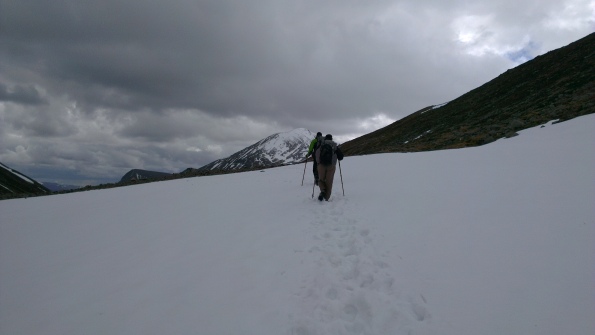 Martin Rye and Philip Werner cross the Lairig Ghru, a less fit hiker trailing in their wake.
Martin Rye and Philip Werner cross the Lairig Ghru, a less fit hiker trailing in their wake.
Regular readers will be very aware that there is nothing to regularly read here, lately in particular. Faced with the realisation, and accompanying statistics, that by far the most frequently visited post on this blog was me having a royal whinge about a shoddy bike I bought last year I slumped somewhat, unable to summon much enthusiasm for what has always only been an occasional dabbling (unlike the blogs of the two gentlemen above, infinitely more professional efforts and worthy of your time). At home on a cloudy bank holiday, still suffering the effects of suspected food poisoning and with the 2013 TGO Challenge behind me, it seems as good a time as any to jot down a few thoughts on recent weeks and what has been going on.
The TGO Challenge, widely acknowledged to be the most significant outdoor event since Pheidippides announced that he was just nipping outside to stretch his legs, concluded last week for another year. I’ve discussed it before on this blog and others have certainly done so with far greater depth and knowledge, so I shan’t be writing a complete trip report, nor a detailed dissection of the gear I carried this year; I do plan to touch on a few elements here and in later posts, though, which may hopefully be of interest when compared with how I tackled the 2011 crossing.
Plenty of people reported exceptionally bad weather early on, whereas I was lucky to see only a pretty typical mix of rain, snow, hail and sun for the first few days before things mostly improved. The worst weather I faced was probably on the campsite at Braemar, indeed, where I was at least in a good position to ride it out. It was a little disconcerting to return to my tent in the early evening and discover a party of ducks disporting in a newly created pond mere feet away, however.
In the first week I made my way to Drumnadrochit, bordering Loch Ness and consequently the leading location for all manner of tat with Nessie printed on it. The crossing, on a boat full of smiling Challengers helmed by the stalwart Gordon Menzies at the wheel, was delightful, with bright sunshine and scarcely a ripple on the surface of the water, although we were visited by at least one voracious creature. I’m no cryptozoologist or else I might have been able to positively identify it as the lake monster of myth, but perhaps you might do better from the hurried photograph I took as it attempted to swamp the boat.
A few miles inland I met a couple of hikers at a road junction, both with the characteristic bearing of TGO Challengers. We’d never met before, but Martin Rye and Philip Werner were familiar to me through Twitter and their blogs and we soon fell in to chatting as we headed off. The two were hiking together and had crossed Loch Ness the previous evening, full of horror stories about a wild and turbulent crossing, clearly bordering on the epic; my own description of an idyllic putter across in the sunshine did seem to deflate the drama somewhat. One thing I did know about Martin and Philip was that they were travelling in a party of three along with the President of the US. Sorry, that should read, along with the president of the US hiking equipment manufacturer, Gossamer Gear. Grant Sible had unfortunately been forced to withdraw from the Challenge at the very start due to illness, which must have been especially galling given that he had travelled all the way from Texas to participate. That’s the story I was told, at least, and certainly it seemed a little early in the Challenge for a shortage of supplies to have been behind his mysterious disappearance, cannibalism accounting for relatively few non-finishers on the event these days. Anyway, I’d been hoping to meet him (for one thing I was using a Gossamer Gear SpinnShelter on this trip and had a mind to fish for pitching tips), but instead found myself hiking and camping with his team-mates for a couple of days, taking his place as a sort of Stunt Grant, if you will. These were some of the very best days on the Challenge for me, wonderful walking and terrific company.
I expect that I’ll be edited out of the final photos, of course, and replaced with a CGI version of Mr Sible. That’s showbiz.






